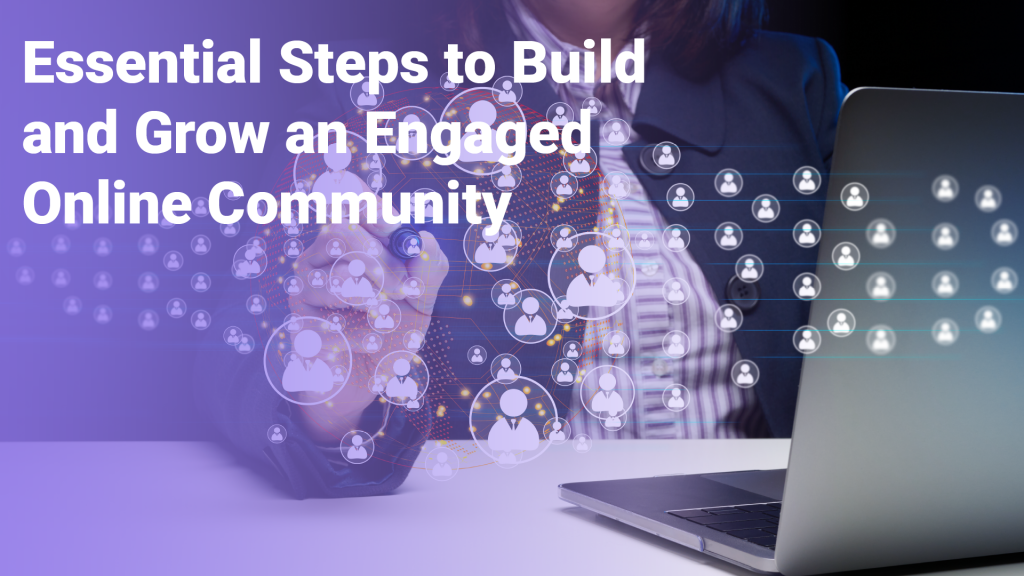
In this blog, we’ll walk you through seven essential steps to help you build a thriving online community. From defining your community to creating valuable content and fostering engagement, we’ll show you how to create a community that fosters meaningful connections, provides value, and stands the test of time.
Building an online community can be a challenging but rewarding experience. Whether you’re a small business owner, an influencer, or someone looking to connect with like-minded individuals, creating a thriving community can provide numerous benefits. From increased engagement and brand loyalty to valuable insights and networking opportunities, a strong online community can be a powerful asset.
But where do you start? Building an online community is not something that happens overnight. It requires careful planning, execution, and nurturing to ensure its success. In this blog post, we’ll outline seven steps to building an online community from scratch, so you can create a space that people will love and keep coming back to.
We’ll start by defining an online community and why it’s important, followed by the steps you need to take to build and grow your community. From identifying your target audience and choosing the right platform to set clear goals, and engaging with your members, we’ll cover everything you need to know to get started.
Building an online community can be fulfilling and exciting, but it requires time, effort, and dedication. Following these seven steps, you can create a community that fosters meaningful connections, provides value, and stands the test of time. So, let’s get started!
Steps To Building An Online Community
Building an online community can be a great way to connect with like-minded individuals, share knowledge and resources, and grow your business or personal brand. However, building a thriving online community is no easy feat. It requires careful planning, execution, and ongoing maintenance to ensure that it remains an engaging and valuable space for its members. This article will walk you through seven essential steps to building an online community from scratch.
Step 1: Define Your Community
The first step in building an online community is defining what it is you want to create. What will be the focus of your community? Who do you want to target? What goals do you want to achieve through your community? Take the time to answer these questions, as they will guide your community-building efforts moving forward.
Step 2: Identify Your Target Audience
Once you have defined your community, the next step is identifying your target audience. Who do you want to attract to your community? What are their interests, needs, and pain points? Understanding your audience will help you create content and engagement strategies that resonate with them.
Step 3: Choose the Right Platform
Choosing the right platform is critical to the success of your community. There are many options, such as social media platforms, online forums, and dedicated community software. Each platform has its strengths and weaknesses, so it’s essential to choose one that aligns with your community’s goals and the needs of your target audience.
Step 4: Set Clear Goals and Objectives
Setting clear goals and objectives is essential for any successful online community. What do you want to achieve through your community? Do you want to increase engagement, drive traffic to your website, or build brand loyalty? Whatever your goals may be, make sure they are specific, measurable, and achievable.
Step 5: Create Valuable Content
Creating valuable content is key to attracting and retaining members in your community. Your content should be informative, educational, and engaging. Consider making a content calendar to ensure you are consistently delivering high-quality content to your audience.
Step 6: Foster Engagement
Engagement is the lifeblood of any online community. Encourage members to engage with each other through comments, likes, and shares. Host contests, challenges, and events to create a sense of community and encourage participation.
Step 7: Monitor and Measure Success
Finally, it’s essential to monitor and measure the success of your online community. Use analytics tools to track engagement, growth, and other metrics that align with your goals. Use this data to make informed decisions about your community’s future and identify areas for improvement.
Building an online community can be time-consuming and challenging, but it can be gratifying with the right approach and strategies.
Virtual Events Can Help You Create Active Online Communities In Less Time
Virtual events can be an effective way to create and maintain active online communities in less time. Here are some ways that virtual events can help you build a thriving online community:
Increase Engagement: Hosting virtual events such as webinars, live streams, and Q&A sessions can help you increase engagement with your community members. These events provide a platform for members to interact with each other and you, fostering a sense of connection and community.
Create Valuable Content: Virtual events can also help you create valuable content for your community. For example, you could host a webinar on a topic that’s relevant to your community’s interests or needs. This content can then be shared and discussed in your online community, further enhancing engagement and creating value for your members.
Reach a Wider Audience: Virtual events can help you reach a wider audience beyond your community. By promoting your events through social media, email marketing, and other channels, you can attract new members to your community who may have yet to find you.
Foster a Sense of Community: Virtual events can also help you foster a sense of community among your members. For example, you could host a virtual happy hour or networking event where members can connect more casually. These events can help build relationships and strengthen the bonds between members.
Provide Opportunities for Collaboration: Virtual events can provide opportunities for collaboration among community members. For example, you could host a virtual hackathon or challenge where members work together to solve a problem or create something new. These collaborative events can help members build relationships and work together towards a common goal.
Community building through a virtual event platform
Community building through virtual event platforms is an effective way to foster engagement and connection among participants. While virtual event platforms primarily serve as a means to host events, they often include features and functionalities that support community building. Here are some ways virtual event platforms can facilitate community building:
1. Networking and Interaction: Virtual event platforms often offer features like chat rooms, discussion boards, and attendee directories, enabling participants to connect, network, and engage in conversations. These features encourage community members to interact and build relationships.
2. Live Q&A and Polling: Interactive elements such as live Q&A sessions and polling allow participants to actively engage with speakers and each other. These features facilitate community building by encouraging dialogue, collaboration, and shared experiences.
3. Virtual Exhibitor Booths: Many virtual event platforms provide virtual exhibitor booths where attendees can visit and interact with exhibitors. This fosters community engagement by creating opportunities for participants to learn about products, services, and initiatives while networking with industry professionals.
4. Gamification: Gamification features, such as leaderboards, badges, and virtual competitions, can incentivize participation and create a sense of community. Participants can earn rewards or recognition for their engagement, fostering a friendly and competitive environment.
5. Post-Event Community: Some virtual event platforms offer post-event community spaces where attendees can continue discussions, access resources, and maintain connections beyond the event. These communities provide ongoing opportunities for engagement and relationship building.
6. Social Media Integration: Virtual Event Platforms often integrate with social media platforms, allowing participants to share event highlights, connect with fellow attendees, and join relevant groups or communities. Social media integration helps extend the community beyond the event platform.
7. Analytics and Insights: Virtual event platforms may provide analytics and insights into attendee engagement, session popularity, and community interactions. These data-driven insights can help organizers identify community trends, understand participant preferences, and tailor future events accordingly.
When selecting a Best Virtual Meeting Platforms for community building, consider the features mentioned above and evaluate how well they align with your community-building goals. Additionally, assess the platform’s ease of use, scalability, and compatibility with your desired engagement strategies.
1. Hopin: Hopin is a comprehensive virtual event platform that offers features for networking, live chat, Q&A, and virtual exhibitor booths. It facilitates interactive experiences and community engagement.
2. Remo: Remo is a virtual event platform with a strong focus on creating networking opportunities. It provides features like virtual tables, breakout rooms, and interactive floor plans, fostering community connections.
3. Attendify: Attendify is an event app and virtual platform that allows participants to engage in discussions, connect with other attendees, and join topic-based communities. It enables ongoing community engagement beyond the event.
4. Socio: Socio is a virtual event platform that offers community building features like attendee profiles, networking opportunities, and interactive sessions. It emphasizes engagement and collaboration among participants.
5. Airmeet: Airmeet is a virtual events platform that offers features like networking lounges, interactive sessions, and attendee engagement tools. It aims to create a social and collaborative environment for community building.
HuddleXR: HuddleXR is a powerful Best Virtual Conference Platforms that excels in community building. With its social wall, question wall, polls, and casual discussion rooms, participants can actively engage, interact, and connect with each other. The platform also offers video-on-demand for content playlists, ensuring convenient access to relevant materials. Moreover, HuddleXR allows integration with other engagement tools, providing flexibility and customization options to enhance the community-building experience.
Whova: Whova is an event management platform that provides community features like attendee profiles, live chat, and community bulletin boards. It aims to enhance participant engagement and community building.
6Connex: 6Connex is a virtual event platform that offers community engagement tools like chat, forums, and virtual meetups. It focuses on creating interactive and collaborative experiences for participants.
Hubilo: Hubilo is an all-in-one virtual event platform that provides community engagement features such as chat rooms, discussion boards, and networking lounges. It aims to foster connections and interactions among participants.
vFairs: vFairs is a virtual event platform that offers networking features, interactive sessions, and virtual booths. It aims to create engaging experiences and facilitate community building within the virtual event environment.
Evaluate the features, pricing, and suitability of each platform based on your specific community-building goals and event requirements.
Final Words
Building an online community can be a challenging but rewarding experience. By following the seven steps we’ve outlined, you can create a community that fosters meaningful connections, provides value, and stands the test of time.
Remember, building a successful online community takes time and effort. It requires careful planning, execution, and ongoing maintenance. But the rewards can be significant. A thriving online community can help you grow your business, expand your brand, and connect with like-minded individuals.
So, take the time to define your community, identify your target audience, choose the right platform, set clear goals and objectives, create valuable content, foster engagement, and monitor and measure success. By doing so, you can create an online community that not only meets the needs of your members but also helps you achieve your business and personal goals.






